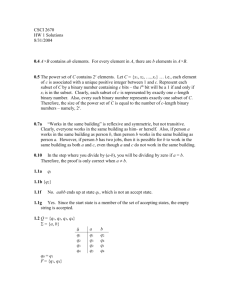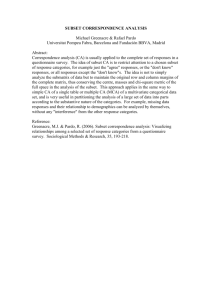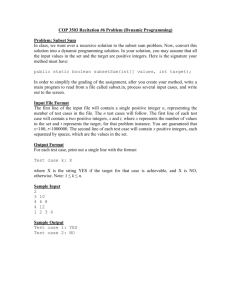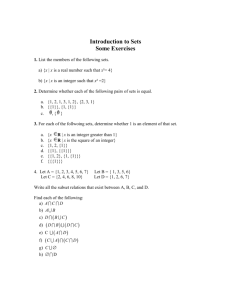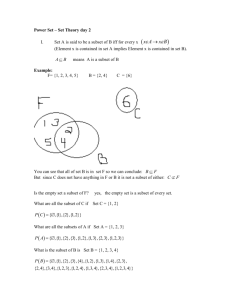3-SAT to Subset Sum
advertisement
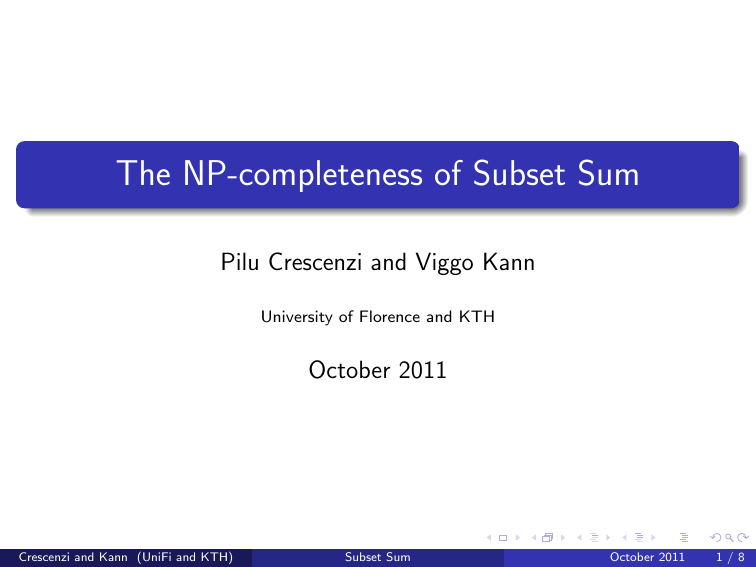
The NP-completeness of Subset Sum Pilu Crescenzi and Viggo Kann University of Florence and KTH October 2011 Crescenzi and Kann (UniFi and KTH) Subset Sum October 2011 1/8 Basic definitions Class NP Set of decision problems that admit “short” and efficiently verifiable solutions Formally, L ∈ NP if and only if there exist polynomial p polynomial-time machine V such that, for any x, x ∈ L ⇔ ∃y (|y | ≤ p(|x|) ∧ V (x, y ) = 1) Polynomial-time reducibility L1 ≤ L2 if there exists polynomial-time computable function f such that, for any x, x ∈ L1 ⇔ f (x) ∈ L2 NP-complete problem L ∈ NP is NP-complete if any language in NP is polynomial-time reducible to L Hardest problem in NP Crescenzi and Kann (UniFi and KTH) Subset Sum October 2011 2/8 Basic results Cook-Levin theorem Sat problem Given a boolean formula in conjunctive normal form (disjunction of conjunctions), is the formula satisfiable? Sat is NP-complete 3-Sat Each clause contains exactly three literals 3-Sat is NP-complete Simple proof by local substitution l1 ⇒ (l1 ∨ y ∨ z) ∧ (l1 ∨ y ∨ z) ∧ (l1 ∨ y ∨ z) ∧ (l1 ∨ y ∨ z) l1 ∨ l2 ⇒ (l1 ∨ l2 ∨ y ) ∧ (l1 ∨ l2 ∨ y ) l1 ∨ l2 ∨ l3 ⇒ l1 ∨ l2 ∨ l3 l1 ∨ l2 ∨ · · · ∨ lk ⇒ (l1 ∨ l2 ∨ y1 ) ∧ (y1 ∨ l3 ∨ y2 ) ∧ (y2 ∨ l4 ∨ y3 ) ∧ · · · ∧ (yk−3 ∨ lk−1 ∨ lk ) Crescenzi and Kann (UniFi and KTH) Subset Sum October 2011 3/8 Problem definition: Subset Sum Given a (multi)set A of integer numbers and an integer number s, does there exist a subset of A such that the sum of its elements is equal to s? No polynomial-time algorithm is known Is in NP (short and verifiable certificates): If a set is “good”, there exists subset B ⊆ A such that the sum of the elements in B is equal to s Length of B encoding is polynomial in length of A encoding There exists a polynomial-time algorithm that verifies whether B is a set of numbers whose sum is s: Verify that Crescenzi and Kann (UniFi and KTH) P a∈B a=s Subset Sum October 2011 4/8 NP-completeness Reduction of 3-Sat to Subset Sum: n variables xi and m clauses cj For each variable xi , construct numbers ti and fi of n + m digits: The i-th digit of ti and fi is equal to 1 For n + 1 ≤ j ≤ n + m, the j-th digit of ti is equal to 1 if xi is in clause cj−n For n + 1 ≤ j ≤ n + m, the j-th digit of fi is equal to 1 if xi is in clause cj−n All other digits of ti and fi are 0 Example: (x1 ∨ x2 ∨ x3 ) ∧ (x1 ∨ x2 ∨ x3 ) ∧ (x1 ∨ x2 ∨ x3 ) ∧ (x1 ∨ x2 ∨ x3 ) Crescenzi and Kann (UniFi and KTH) Number 1 i 2 3 1 2 j 3 4 t1 f1 t2 f2 t3 f3 1 1 0 0 0 0 0 0 1 1 0 0 0 0 0 0 1 1 1 0 1 0 1 0 0 1 0 1 1 0 0 1 1 0 0 1 1 0 0 1 1 0 Subset Sum October 2011 5/8 For each clause cj , construct numbers xj and yj of n + m digits: The (n + j)-th digit of xj and yj is equal to 1 All other digits of xi and yj are 0 Example: (x1 ∨ x2 ∨ x3 ) ∧ (x1 ∨ x2 ∨ x3 ) ∧ (x1 ∨ x2 ∨ x3 ) ∧ (x1 ∨ x2 ∨ x3 ) Number 1 i 2 3 1 2 j 3 4 x1 y1 x2 y2 x3 y3 x4 y4 0 0 0 0 0 0 0 0 0 0 0 0 0 0 0 0 0 0 0 0 0 0 0 0 1 1 0 0 0 0 0 0 0 0 1 1 0 0 0 0 0 0 0 0 1 1 0 0 0 0 0 0 0 0 1 1 Finally, construct a sum number s of n + m digits: For 1 ≤ j ≤ n, the j-th digit of s is equal to 1 For n + 1 ≤ j ≤ n + m, the j-th digit of s is equal to 3 Crescenzi and Kann (UniFi and KTH) Subset Sum October 2011 6/8 Proof of correctness Show that Formula satisfiable ⇒ Subset exists: Take ti if xi is true Take fi if xi is false Take xj if number of true literals in cj is at most 2 Take yj if number of true literals in cj is 1 Example (x1 ∨ x2 ∨ x3 ) ∧ (x1 ∨ x2 ∨ x3 ) ∧ (x1 ∨ x2 ∨ x3 ) ∧ (x1 ∨ x2 ∨ x3 ) All variables true Crescenzi and Kann (UniFi and KTH) Number 1 i 2 3 1 2 3 4 t1 t2 t3 1 0 0 0 1 0 0 0 1 1 1 1 0 0 1 0 1 0 1 0 1 x2 y2 x3 y3 x4 0 0 0 0 0 0 0 0 0 0 0 0 0 0 0 0 0 0 0 0 1 1 0 0 0 0 0 1 1 0 0 0 0 0 1 s 1 1 1 3 3 3 3 Subset Sum j October 2011 7/8 Show that Subset exists ⇒ Formula satisfiable: Assign value true to xi if ti is in subset Assign value false to xi if fi is in subset Exactly one number per variable must be in the subset Otherwise one of first n digits of the sum is greater than 1 Assignment is consistent At least one variable number corresponding to a literal in a clause must be in the subset Otherwise one of next m digits of the sum is smaller than 3 Each clause is satisfied Crescenzi and Kann (UniFi and KTH) Subset Sum October 2011 8/8



